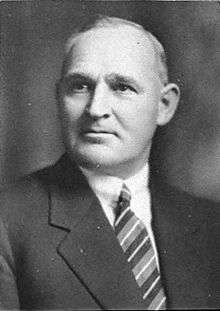Frank Langstone
| The Honourable Frank Langstone | |
|---|---|
 | |
| 25th Minister of Native Affairs | |
|
In office 1 April 1940 – 21 December 1942 | |
| Prime Minister | Peter Fraser |
| Preceded by | Michael Joseph Savage |
| Succeeded by | Rex Mason |
| 11th President of the Labour Party | |
|
In office 1933–1934 | |
| Vice President | Clyde Carr |
| Leader | Michael Joseph Savage |
| Preceded by | Rex Mason |
| Succeeded by | Tim Armstrong |
| Personal details | |
| Born |
1881 Bulls, New Zealand |
| Died |
(aged 88) New Zealand |
| Political party | Labour (1916–1949) |
| Other political affiliations | Social Credit (1957-1969) |
Frank Langstone (1881 – 15 June 1969) was a New Zealand Member of Parliament, Cabinet Minister and High Commissioner to Canada.
Early life
Langstone was born in Bulls in 1881.[1] He was a shearer and was involved in the Shearers' Union in the King Country. Later, he was the proprietor of a railway restaurant in Taumarunui, and a fish-and-chip shop.[2][1] He was involved with setting up the left-wing Maoriland Worker in 1910.
Political career
| Parliament of New Zealand | ||||
| Years | Term | Electorate | Party | |
| 1922–1925 | 21st | Waimarino | Labour | |
| 1928–1931 | 23rd | Waimarino | Labour | |
| 1931–1935 | 24th | Waimarino | Labour | |
| 1935–1938 | 25th | Waimarino | Labour | |
| 1938–1943 | 26th | Waimarino | Labour | |
| 1943–1946 | 27th | Waimarino | Labour | |
| 1946–1949 | 28th | Roskill | Labour | |
Langstone first contested the Waimarino electorate in the 1919 election, but was beaten by the incumbent, Robert William Smith of the Liberal Party.[3][4] Langstone and Smith contested Waimarino at the 1922 election and this time, Langstone was successful. He held the electorate until 1925 and again from 1928 to 1946.[5] He then held the Roskill electorate from 1946 to 1949.[5] He was Minister of Lands (1935–1942), Commissioner of State Forests (1935–1942), Minister of External Affairs (1940–1942),[6] Native Minister (1940–1942), and Minister for the Cook Islands (1940–1942).[7] In 1942 he became High Commissioner to Canada.[1] Langstone was President of the New Zealand Labour Party from 1933 to 1934.[1] In 1935, he was awarded the King George V Silver Jubilee Medal.[8]
He was described as "a cheerful, shortish extrovert with a better brain than most people thought he had". As he was deaf, he was allowed to listen to debates in the chamber on a small radio with headphones. When a dull back-bencher was on, he was known to tune into livelier commercial stations, when he would beat time to the music with his hands.[2]
In 1949 Langstone resigned from the Labour Party over the issue of peacetime conscription.[1] Later that year he stood in the Roskill electorate as an Independent but was defeated; coming third with 1097 votes after Rae (National, 7372 votes) and Freeman (Labour, 5957 votes). In 1957 and 1960 he stood for Social Credit in Roskill.[1]
Death
Langstone died on 15 June 1969, and his ashes were buried at Purewa Cemetery, Auckland.[9]
Further reading
- Hobbs, Leslie (1967). The Thirty-Year Wonders. Christchurch: Whitcombe and Tombs.
- The 1949 General Election by S.E. Fraser (1967, MA Thesis-University of Otago, Dunedin)
- The Last Years of the First Labour Government 1945-1949 by R. McLennan (1963, MA Thesis-University of Auckland, Auckland)
- The Expulsion of John A. Lee and its Effects on the Development of the Labour Party by B.S. Taylor (1970, MA Thesis-University of Canterbury, Christchurch)
Notes
- 1 2 3 4 5 6 Gustafson 1980, p. 159.
- 1 2 Hobbs 1967, pp. 126,127.
- ↑ The New Zealand Official Year-Book. Government Printer. 1920. Retrieved 2 August 2013.
- ↑ "The Polling". Otago Daily Times (17811). 18 December 1919. p. 6. Retrieved 15 November 2013.
- 1 2 Wilson 1985, p. 211.
- ↑ New Zealand Parliamentary Debates, Vol. 260-261 (1940-1942).
- ↑ Wilson 1985, pp. 82f.
- ↑ "Official jubilee medals". The Evening Post. 6 May 1935. p. 4. Retrieved 15 November 2013.
- ↑ "Burial & cremation details". Purewa Cemetery and Crematorium. Retrieved 3 April 2016.
References
- Gustafson, Barry (1980). Labour's path to political independence: The Origins and Establishment of the New Zealand Labour Party, 1900–19. Auckland, New Zealand: Auckland University Press. ISBN 0-19-647986-X.
- Wilson, James Oakley (1985) [First published in 1913]. New Zealand Parliamentary Record, 1840–1984 (4th ed.). Wellington: V.R. Ward, Govt. Printer. OCLC 154283103.
| New Zealand Parliament | ||
|---|---|---|
| Preceded by Robert William Smith |
Member of Parliament for Waimarino 1922–1925 1928–1946 |
Succeeded by Robert William Smith |
| Succeeded by Paddy Kearins | ||
| Preceded by Arthur Shapton Richards |
Member of Parliament for Roskill 1946–1949 |
Succeeded by John Rae |
| Party political offices | ||
| Preceded by Bill Jordan |
President of the Labour Party 1933–1934 |
Succeeded by Tim Armstrong |